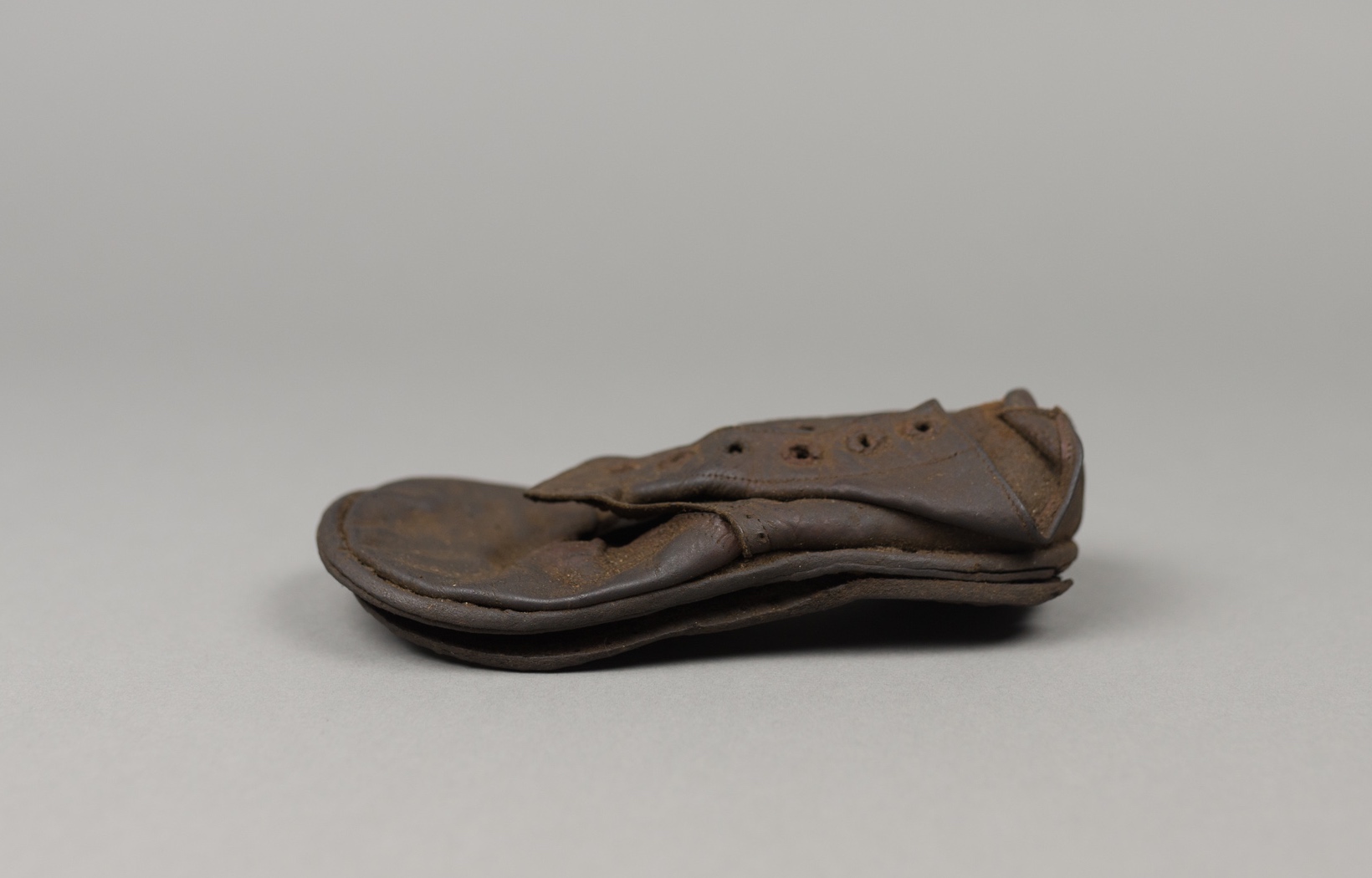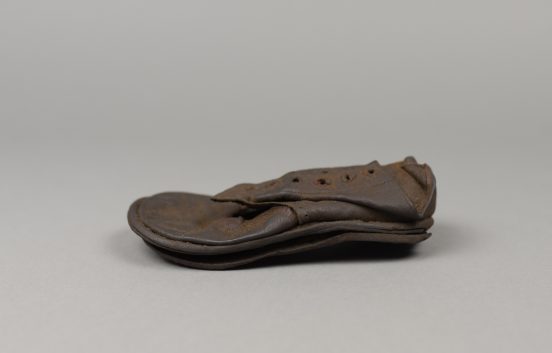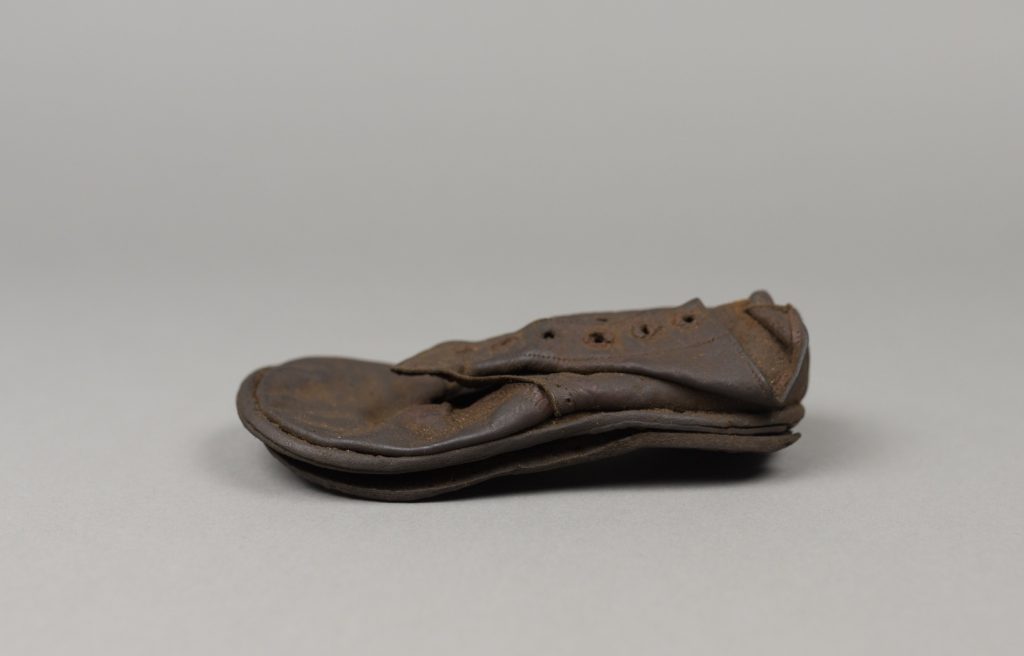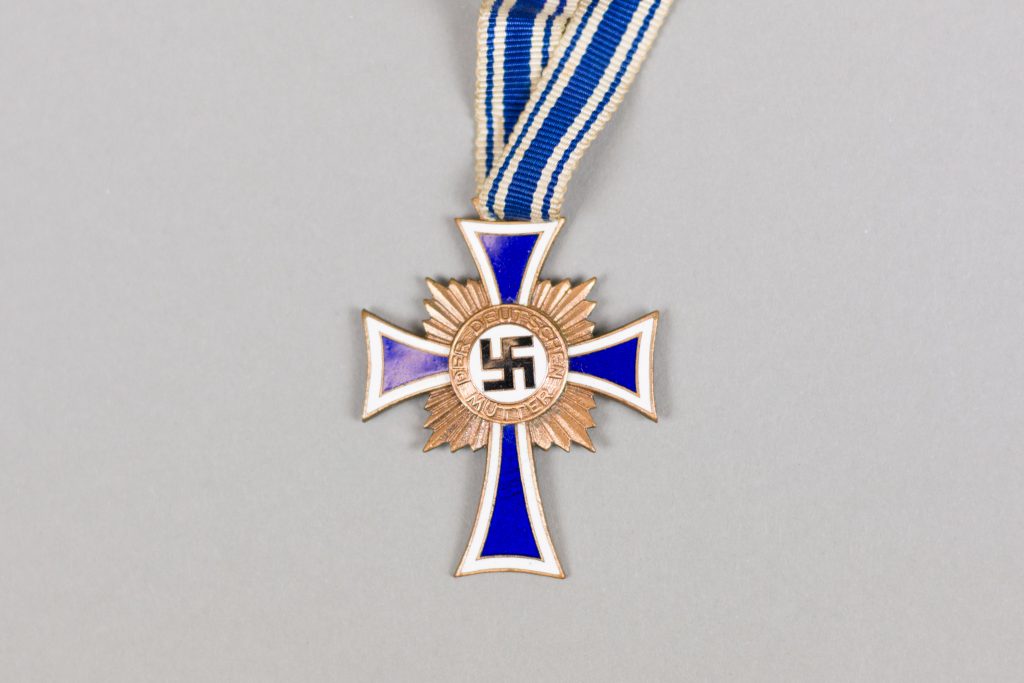By Madeleine Deis
| Name of the Artefact | Child’s Shoe | Cross of Honor of the German Mother |
| Creator | Unknown: recovered from the Kanada barracks at Auschwitz Birkenau | Issued by: Nationalsozialistiche Deautsche Arbeiter-Partei |
| Date | Before 1940s | 1939-1945 |
| Type | Leather shoe | Bronze medal |
| Image |  |  |
| URL |
The Holocaust Through the Lens of German Mothers and Stolen Children
Overview
This brown leather shoe was discovered in the Kanada barracks at Auschwitz-Birkenau. It is missing a sole and the laces are gone. It was made before the 1940’s, presumably in Germany, but that information is not concrete due to the fact that the owner of the shoe is unknown. The creator of the shoe is unknown as well. A child’s shoe at this time would have cost between 2 and 4 American dollars, or 5 to 10 German Marks.
This Cross of Honour was issued by the Nationalsozialistische Deutsche Arbeiter-Partei, or the Nazi party, and the back of the medal was engraved with the words “16. Dezember 1938. Adolf Hitler” by the Carl Poellath Schrobenhausen GmbH. A bronze medal such as this was awarded to a German mother who fostered or conceived four to five children during the war, which was considered a significant effort in contributing to population growth and thereby helping the Nazi party. Women who conceived or fostered six or seven children received a silver medal, and women who were able to conceive or foster eight or more children received a gold medal. This particular Cross of Honour was made between the years of 1939 and 1945. There is no information on how much a badge like this would have cost.
Meaning
To a child, a shoe is most likely one of the least relevant things in their lives. It is something that they hastily slip on as they run outside with their friends to play jump rope, or trip on the untied laces as they are walking down the street holding their mother’s hand. During this time period, a child most likely only had one or two pairs of shoes depending on the social class they came from. Shoes were probably not in the forefront of this child’s mind, until they were no longer allowed to wear shoes and were forced to stand at roll call or march to the gas chambers barefoot. Shoes are something that many of us take for granted; we may not think about the privilege of having something to wear on our feet every day—that is, until that privilege is taken away.
The Cross of Honor of the German Mother was a significant use of Nazi propaganda to award women aiding the war effort on the German side. Having children and fostering those deemed as “children in need” was one of the few ways that women were able to contribute to the war. Other ways included nursing, teaching, and being dutiful German wives to their husbands (Lower). Children who came from non-Aryan backgrounds but had features that looked like what the Germans saw as ideal, specifically blond hair blue eyes (Lower 36), were taken away from their birth parents and placed with new Aryan parents. Most of the time their birth parents were killed or taken to forced labour camps, and these children were presumably never made aware of the fate of their parents. The women who received these stolen children were “women who were infertile or had miscarried, and who were desperate to prove their racial merit by becoming mothers” (Lower 36). Receiving this medal was most likely extremely honourable, and the women to whom they were awarded most likely felt proud of their contribution to the advancement of the German race.
Symbolism
Auschwitz. Death. Cold. Pain. Just a few of the many words we associate with the Holocaust. We can also think of the small souls whose feet had to freeze as they were marched to the gas chambers. Children are not good workers, children are too small and weak to be of any use, they are not worthy of life—these were the conclusions the Nazis might have come to in the camps in order to justify killing children. We can take the shoes of the Jewish children and send them to the non-Jewish Germans back in the Reich, they might have thought. One must die in order for another to thrive. The child’s shoe embodies the lives that were cut short by terrible evil. Our current lack of information as to whom the shoe belonged exemplifies its own powerful message: this child did not matter. Perhaps if that child had blond hair or blue eyes, their fate would have been different. Perhaps they could have grown up in a household with many brothers and sisters, and their mother could have received a medal for doing honorable work for the survival of their race. This mother might have felt proud of herself for taking in a child that was stolen from non-desirable parents, and raising them the “correct” way. One of the highest honours was the ability to contribute, and what better way than shaping the children of today, the leaders of tomorrow? It is plausible that this mother even received shoes coming from concentration camps, the stolen shoes of those who had no chance at life, and dressed her stolen children with them. Of these two artefacts, one symbolizes loss, despair, and pain, while the other would have symbolized courage and dedication to the Nazi cause.
Aftermath
One could argue that the symbolism of this child’s shoe grows stronger in the 21st century. At the time of the Holocaust, this item symbolized the suffering and loss that so many people had to endure, but as the years go on it evolves into a reminder of what human beings are capable of. The fact that it is a child’s shoe exemplifies the evil that was committed to even the most vulnerable and innocent of humanity, on grounds that still make no sense today. It is one singular shoe, not a pile of shoes, it is one shoe that belonged to one child, one story amongst the hundreds of thousands. We cannot know exactly what happened to this particular child, but we can speculate. Perhaps “they had to make room” (“From the Testimony of Hilde Sherman” 37) for new arrivals, as Hilde Sherman describes on her arrival to the Riga ghetto. Or maybe they were simply chosen out of a lineup and sent to the gas chambers because they were too small, too frail or too young-looking. As time goes on, we are continually and rightfully reminded by artefacts, such as this shoe, of the loss and tragedy of the Holocaust and World War II.
Do the women who raised these stolen children as their own feel any guilt for this? Or do they still believe that they have done what is best for their country? Jean Améry writes about collective guilt and describes how Germans saw themselves as victims (Améry 66). Does this still hold true to the mothers who most likely claimed these children as their own? We can speculate that the women who fostered the children most likely did not think about the long-term damage that they were contributing to, and thought solely about the amount of good that they thought they were providing their country with. If they received child clothing “donations” from concentration camp victims, we can assume that there was never a thought as to the actual consequences of these items. The Cross of Honor was most likely a way of making these women feel important without encouraging the critical thinking of what they were actually contributing to. At the time of the war, being awarded this badge would be a symbol of a duty that is upheld, a duty to one’s country and the survival of the Aryan German race. However, as time wore on, past the wartime years and into years of healing and reconciliation, this Cross of “Honor” most likely became a symbol of kidnapping, loss and racial hierarchy.
Conclusion
Acknowledgement and remembrance of the Holocaust becomes increasingly more important as history continues on. It is vital that we educate ourselves on the doings of the past, and part of that education could include pondering artefacts such as these and thinking about the deeper meanings they are able to convey. It is interesting to examine how the meanings of each artefact changes over time, and if the significance deepens in ways we may not be able to predict. The two artefacts of the Cross of Honor of the German Mother and the Child’s Shoe tell two very different stories, but stories that could very easily intertwine. Yet the feelings behind each one remain somewhat ambiguous. We are unable to know how that German mother felt when she received the Cross, and cannot know how the child who lost their shoe felt about their experiences. We are solely able to speculate and reflect on the significance of these two objects, and use them as markers of the past as we advance into the 21st century.
Works Cited
Améry Jean. At the Minds Limits: Contemplations by a Survivor on Auschwitz and Its Realities. Indiana University Press, 1980.
Child’s Shoe. Pre-1940s. Vancouver Holocaust Education Centre, https://collections.vhec.org/Detail/objects/2435
“From the Testimony of Hilde Sherman about the Deportation to Riga and the Arrival to the Ghetto.” Yad Vashem Archives, The International School for Holocaust Studies, https://www.yadvashem.org/odot_pdf/Microsoft%20Word%20-%203287.pdf. Accessed 07 May 2020.
Lower, Wendy. Hitler’s Furies: German Women in the Nazi Killing Fields. Houghton Mifflin Harcourt, 2014.
Nationalsozialistische Deutsche Arbeiter-Partei. Cross of Honor of the German Mother. Circa 1939-1945. Vancouver Holocaust Education Centre, https://collections.vhec.org/Detail/objects/1908




Comments by Amanda Grey